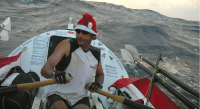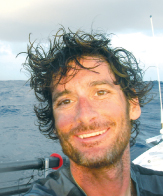
Seventy-six Days at Sea, Part 1: B.C. chiropractor rows solo across the Atlantic
By Maria DiDanieli
Features Leadership Profession“The ship was cheered, the harbour cleared,
Merrily did we drop
Below the kirk, below the hill,
Below the lighthouse top.” –Samuel Taylor Coleridge
 |
| B.C. chiropractor Dr. Paul Attalla spends Christmas in The Spirit of Fernie. |
“The ship was cheered, the harbour cleared,
Merrily did we drop
Below the kirk, below the hill,
Below the lighthouse top.” –Samuel Taylor Coleridge
Twenty minutes before the start of the race, I was on the water reading the instruction manuals for my boat,” says Dr. Paul Attalla, from his home in Fernie, British Columbia.
Attalla has been home, now, for a little over a month, having completed the international Atlantic Rowing Race 2007, a solo rowing journey that took him from San Sebastian, La Gomera, in the Canary Islands, to Antigua, West Indies – a distance of 5,500 kilometres – in a seven- metre rowboat. The 36-year-old graduate of Western States Chiropractic College, and father of two, had prepared himself for seven years to challenge this race, seeing it as the hardest physical endeavour that he could undertake.
“To row, solo, across the Altantic Ocean is hard,” he notes, “but I thought I could do it. However, just to get to the start line was a monumental effort in itself!”
TRAINING, PREPARATION AND THE ADVANTAGE OF BEING A CHIROPRACTOR
“Physical and mental training went hand in hand, in preparing for this race,” says Dr. Attalla. “Over the seven years during which I trained, I did the hardest races I could find. I picked these races, in particular, partly to see if I could finish them, but also to see if I would enjoy them.”
Attalla’s history does, indeed, reveal some pretty amazing races – with some impressive finish results. The events in which Attala raced and won accolades include mountain biking and kayak racing. After placing fourth in the solo category for the 60-kilometer Yukon River Quest kayak race in 2005, he knew he was ready to undertake the rigours of rowing solo in the biggest single rowing race he could find.
And then, he pulled away from the racing circuit. But Attalla proceeded with the courses he required to qualify for the Atlantic Rowing Race, including designation as Master Yachtsman, as well as his Sea Survival, First Aid at Sea and radio licence registrations.
Attalla did not restrict his training to building endurance and strength. As a chiropractor, he knew that he had to teach his body how not to get hurt, during the tough Atlantic journey. He knew that he had to become physically tougher and not just stronger. Attalla would bike into the B.C. wilds to deliberately earn himself bumps and bruises similar to the extent of injuries he could expect to sustain on a rowboat in the Atlantic Ocean.
On a different plane, Dr. Paul made sure that he took care of his spirit by guarding his time with his young family. While training, he would find creative ways to incorporate them; for example, by taking the kids biking with him and teaching them their ABC’s along the way.
“Although, toward the end I certainly was not the husband or father that I could be,” Attalla quietly admits. “I tried to not let training interfere with family time, and to involve them as much as I could.”
Preparation for this sort of endeavour, of course, also requires that the participant find supporters for the venture.
“In total, it cost $200 000, just to get to the start line of the race.” says Attalla. He is grateful to the British Columbia Chiropractic Association as well as to Scotiabank, who came in at the 11th hour with just the support needed to turn the dream of participating in the race into a reality.
Toward the very end of the preparation period, Attalla recognized that not being in San Sebastian around the other rowers probably kept him from the contagion of panic that seemed to afflict them. Attalla kept his mind on the fact that he intended to stay happy and have fun during the race! But also, Attalla was much too busy with the completion of the one thing that should have seemed obviously important enough to warrant a high level of sustained attention from its crafters – his boat!
 |
| Dr. Paul, at sea, at last! |
THE WOODVALE SOLO-CLASS ROWBOAT
Attalla’s craft, christened “The Spirit of Fernie”, was a Woodvale solo-class rowing boat – with no sails or motors involved. Its length was seven metres, its beam measured two metres and weighed 280 kilograms. The boat was designed to give the long-distance solo rower the comfort and stowage to complete ocean crossings. The craft’s cabin volumes made the boat highly self-righting and the lowered aft cabin floor made it possible for the rower to sit upright, not stooping, when taking shelter from weather. The addition of a centre board to this type of boat meant that it could be rowed into weather.
Rowboats for these competitions are made, largely, in the United Kingdom – and there are no manufacturers in Canada. Approximately two years before the race, Attalla hired a marine architect and hooked up with a manufacturer in England, who assured him his boat would be ready well in time for the race. Keeping in regular contact with the company that was building his boat offered Attalla assurance that everything was progressing nicely and, so, he remained relatively relaxed, at least as far as his craft was concerned – until one day in September 2007, just weeks before the start of the race, he received a call informing him that his boat was far from finished and would probably not be ready on time.
How could this be?
THE RACE TO THE STARTING LINE
Attalla was faced with the possibility of his dream being washed out to sea without him. At this point, Attalla’s happy anticipation and positive thoughts abandoned him and he became seriously determined not to legitimize the doubts held by the race’s organizers, regarding the success of a Canadian entering, never mind finishing, the race. He knew he had been considered a long shot but he had no intention to turn that speculation into reality.
Off he flew to Heathrow Airport, from whence, without issuing warning to the manufacturer, he headed straight to where his boat was being stalled.
For two weeks, Attalla worked with the craftsmen who were building his boat. Not having planned for resources to support a trip to England, Attalla camped out in the manufacturer’s office – to their chagrin – while diverting the efforts of as many workers as possible to his own craft. At the end of this stint, Attalla went home and remained on pins and needles right up to the day of the race, as his boat encountered glitch after glitch in its creation.
But, just in time for the starting line, the boat hit the water in San Sebastian, with Paul Attalla in it. Despite the challenge to be ready for the start of the race, Attalla remains greatful to all who crafted his vessel.
“The people in San Sebastian were not only friendly but very helpful, toward the end,” recalls Attalla gratefully.
He recruited his two daughters, Amy and Joy, to help him decorate the boat with stickers and with the good luck notes he had received from family, friends and colleagues. On December 2, 2007, amid the sounds of his friends and family singing O Canada, and the blowing of party horns, the race began.
“I took one huge stroke out,” he recalls, “and threw my arms into the air. As far as I was concerned, I had earned one victory already.”
Please join us in our next issue for Part 2 of “Seventy-six Days at Sea” Dr. Attalla tells Canadian Chiropractor about his time at sea and how being a chiropractor influenced his progress during the race. Find out how the journey has impacted his life and his practice – and enjoy Dr. Attalla’s photos of his amazing Atlantic voyage.
Print this page